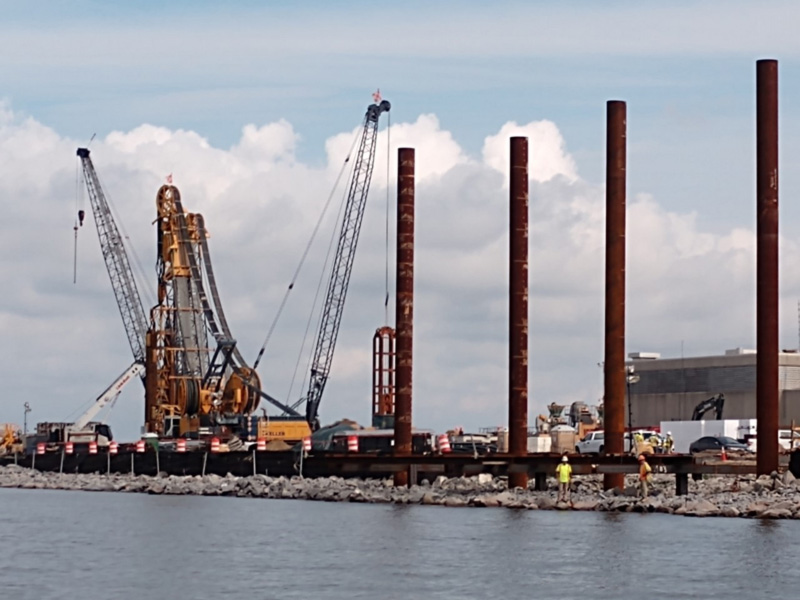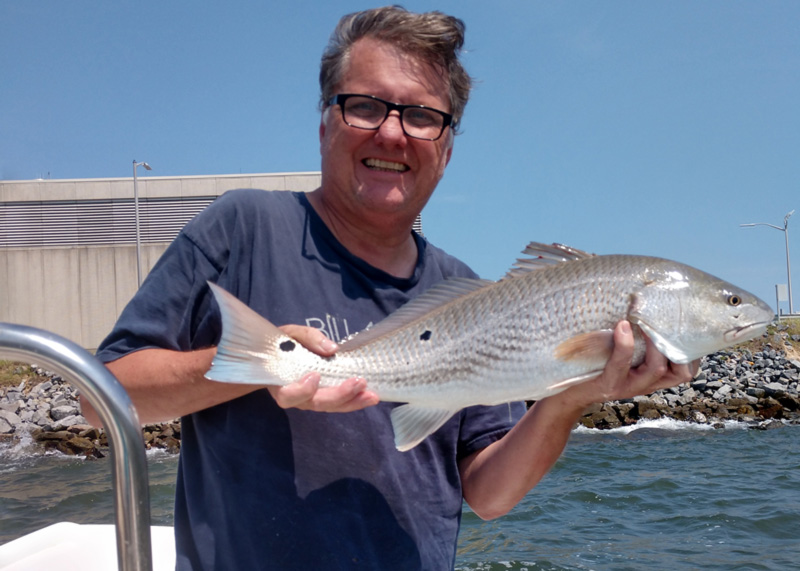As a resident of the Hampton Roads area for most of my life, I should have nothing but happy thoughts about the doubling of the size of the Hampton Roads Bridge-Tunnel (HRBT). Heck, when I was in college I even worked on the construction of the southbound tunnel tube one summer. Before you get impressed with that, it was a “general construction” job, mostly working with a jack hammer or a broom inside the almost completed tunnel. And as a local, I have waited in traffic at the HRBT way too many times to count…. so this expansion should come only as good news.

But I also spend a lot time fishing under the bridges and over the tubes of the HRBT. It is, in fact, one of my two favorite places to fish. The other place is the Chesapeake Bay Bridge-Tunnel (CBBT) which is also under a similar construction project. You may have seen my article CBBT Tunnel Construction Update on that project in the August 2020 issue. Briefly, the existing tunnels are “immersion-tube” tunnels, while the new ones are “bored” tunnels. I would point you to that article for a discussion of the “boring” type of tunnel construction.
Here’s a quote from the official HRBT Expansion website:
"The I-64 Hampton Roads Bridge-Tunnel in southeastern Virginia has long been one of the region’s most congested corridors. The existing 3.5-mile facility consists of two two-lane immersed-tube tunnels on artificial islands, with trestle bridges to shore. These tunnels opened in 1957 (current westbound lanes) and 1976 (eastbound lanes) and are approximately 7500 feet long. Traffic on these four lanes exceeds 100,000 vehicles per day during peak summer traffic. The Hampton Roads Bridge-Tunnel Expansion Project will ease this congestion with the addition of twin two-lane bored tunnels just west of the existing eastbound tunnel. Also, the four-lane segments of the I-64 corridor in the cities of Hampton and Norfolk will be widened."
As I mentioned in the previous article, the advantage of “bored” tunnels is that they are built in a hole bored below the bottom of the channel. In this way, they have much less impact on fishing once completed. It is that “once completed” part I want to emphasize. While they are being constructed, there is a lot of impact on fishing. Added to this is the fact that at the HRBT they are also adding new bridges and roadways to feed into the new tunnels (including replacement of existing bridges and roadways). At the CBBT, the new bridges were built years ago. The good news is that several years from now, traffic flowing into and out of our region should be greatly improved. This project is slated to be completed in 2025 and cost $3.8 billion dollars.
As with the CBBT tunnel project, work at the HRBT will progress from south to north. Preliminary work has begun on the South Island (closest to Norfolk). This preliminary work involves preparing the existing island to receive the Tunnel Boring Machine (TBM) sometime late next year. Boring is set to begin in 2022.
“What about the seagulls?” you may ask. The South Island has long been a nesting site for thousands of sea birds. They are employing a high-tech answer for this: basically, the plan involves border collies scaring the birds over to nearby Fort Wool.
Impact on Fishing at the HRBT
What FishTalk readers are most interested in, of course, is the project’s impact on the fishing here. As with the CBBT project, the biggest impact during construction will be on the sides of the islands. In the case of the HRBT, the new roadways and tunnels will be placed to the west of the existing structure. For those who are directionally challenged, this is the side inside the harbor, closest to the traffic heading to Norfolk.
That means this project will highly impact one of my own favorite fishing locations. As I write this, three days ago I caught nice speckled trout and puppy drum along the side of the North Island (closest to Hampton). I work this area just about every time I fish the HRBT. So far this island has not changed, but chances are it won’t remain so for long. My other favorite places to fish the HRBT are the two ends of this island (under the bridge and over the tube). These are the other areas that will be severely impacted. Ironically, the area of the island that will be affected the least (the east side) has never been as productive for me.

Fortunately, the area along the western side of the South Island (closest to Norfolk) is not a very productive fishing location, and this is the area that will be affected the most by the project. In fact, it doesn’t appear that fishing the Norfolk end of the HRBT will be affected that much. Of course, I may be wrong about that!
My favorite species to target at the HRBT are flounder, puppy (red) drum, and speckled trout. Fortunately, each of these species may be caught in various places in our region. Here is a brief rundown of fishing for each of these species at the HRBT.
Flounder have not been plentiful around the HRBT in recent years. However, this summer I caught flounder up to 22 inches around this structure. I look for them under the bridges near the islands, and over the tubes near the north island.
Puppy drum, mostly in “the slot” (between 18 and 26 inches) may be found in various areas around the HRBT. My go-to places to find them are over the tube, along the side of the north island, and under the bridge near the south island. They may be caught in summer or fall with small live bait (like spot or croakers) or with jigs.
Speckled trout are mainly a late summer and fall fish in this area, however they may be found just about any time. My personal best was caught at the HRBT several years ago in early June. Large specks have been more common in the past couple of years (after several years of mostly smaller fish). I have done well in the same places that I fish for flounder and puppy drum along with a couple of “secret” holes.
Other species which may be affected by the project include stripers, gray trout, bluefish, and to a lesser extent, spot and croaker. Stripers usually show up in the fall as the water temperatures drop. Though not many cows are caught around the HRBT, there is a decent fishery for smaller rockfish. We will have to see how this project affects them. It has been a few years since I caught a gray trout big enough for me to keep, but smaller fish around 12 inches do frequent these waters throughout the summer and into fall. Lots of small blues may also be found around both islands throughout the season. Spot and croaker are much less structure oriented, so I don’t expect a lot of change in that fishery.
With this bridge tunnel project, a lot of favorite HRBT fishing locations will be impacted. I have already started scoping out a large “flat” nearby for fall speck fishing, should the impact prove to be adverse. My hope is that the fish that typically populate the affected areas will simply move to other locations close to the bridge tunnel (like that flat) as construction takes place. That remains to be seen, but whether or not this happens, people who fish the HRBT will have to be open to finding some new fishing holes over the next several years. And hopefully, we will speed along through the new tunnels as we travel between Norfolk and Hampton in the near future.
Where are the tauog?
Angler in Chief Lenny and I got into a conversation recently about possible tautog fishing at the HRBT. These fish are commonly caught at the CBBT and on reefs and wrecks in our area, but I’ve never known many to be caught around the HRBT. So. The last time I went out I took some crabs and looked for togs over the tubes. I didn’t find any — not that it doesn’t mean they aren’t there.
-By Chuck Harrison
Sign up here to get the weekly FishTalk Chesapeake Bay and Mid-Atlantic fishing reports in your email inbox, every Friday by noon.